A Budget Home Theater & PC Setup: 4K, HDR, UHD Blu-ray, and More
by Ganesh T S on December 26, 2017 8:30 AM ESTLocal Media Playback
Our typical HTPC testing flow involves playing back files encompassing a range of relevant codecs, containers, resolutions, and frame rates. A note of the efficiency is also made by tracking GPU usage and power consumption of the system at the wall. Over the last year or two, the focus has been on using Kodi and MPC-HC with its built-in LAV filters for benchmarking. Even though we have had non-HDR 4K clips for some time now in our test suite, we have not subject them playback at native resolution. In order to augment our test suite, we have added two files, a 4Kp25 HEVC HDR stream in a MKV container, and a 4Kp60 VP9 Profile 2 HDR stream in a WebM container.
Out of all the options we evaluated, the TCL 55P607's in-built Roku platform is the only one capable of handling Dolby Vision videos. However, when we tried to play back a sample file, the Roku interface stalled in the retrieving stage after the appearance of the Dolby Vision logo.
The TCL 55P607 Roku Media Player App - Unable to Handle Local Dolby Vision Files
Due to the absence of reliable open-source editing and decoding tools for Dolby Vision in the PC space, its testing with local media files will have to wait.
The Roku Media Player app continues to be a disappointment for users with anything other than the standard H.264 / HEVC-based camcorder files. The following recorded clip shows its failure with some interlaced MPEG-2 and H.264 clips in TS containers. VC-1 is also not supported.
On the plus side, we have automatic switching to HDR for local files which have HEVC HDR content. On the othr hand, a VP9 Profile 2 HDR clip did not generate the mode switch.
We tracked the power consumption of the TV while the Roku interface tried playing back the various files in our test suite. It was not much of a surprise to find that Roku fails to play back many of the streams. The graph segments below corresponding to the files that didn't play back are just the display remaining idle in the Roku USB Player interface.
The NVIDIA SATV supports all files in our test suite except the one encoded in VP9 Profile 2. With Kodi, we even see the HEVC HDR file being decoded and sent to the display with the appropriate mode switch.
The NVIDIA SHIELD Android TV Supports HDR Playback with Local Files
The power consumption of the SATV was tracked during the playback of each file in our test suite using Kodi 17.6. The segment corresponding to the VP9 Profile 2 file is just the duration for which the audio track was decoded and the Kodi UI remained idle.
Moving on to the PC space, we first compare the DXVAChecker outputs for the three systems. The Zotac EN1080K with its GTX 1080 GPU does not support hardware decoding of VP9 Profile 2 videos. Even if a HDR stream were to be available, the system plays back only the non-HDR versions with the desktop in HDR mode.
The Absence of VP9 10-bit Profile 2 Decoding in the GTX 1080 is the Only Odd Spot (from L to R: ASRock Beebox-S 7200U, Zotac ZBOX MAGNUS EN1080K, and the Intel NUC7i7BNHX1)
We found the native Microsoft Movies & TV app to be capable of playing back HDR videos with the desktop in HDR mode. A comparison of playback using two different players in that mode is shown below.
However, the playback of HDR files in non-HDR mode using the Microsoft Movies & TV App results in messed up colors. As such, we don't recommend the Movies & TV app for HDR file playback under all circumstances.
It is possible to use the madVR renderer in conjunction with a suitable player to shift the display to HDR mode independent of the OS setting. It is also supposed to bring the display back to the original state when exiting. We tested it out with MPC-HC and madVR v0.92.10 on the Zotac EN1080K. On the KBL-U systems, using madVR as the renderer resulted in evident dropped frames irrespective of the setting. On the Zotac EN1080K, we found that the latest NVIDIA driver release (which we absolutely had to use for Netflix 4K playback) seemed to have some issues with the restoration of the previous mode. With certain settings, the colors seemed to get crushed significantly after madVR triggered the mode change.
In fact, the only reliable combination in which we could get playback of the files in the appropriate mode was to set the OS toggle for HDR, and allow madVR to pass through the HDR metadata directly to the display (something that the madVR author specifically mentions as unsuitable for purists). We do not have automatic mode switching or even identification of HDR when using Kodi (as of v17.6). With madVR and MPC-HC, it is possible, but the consumer experience may vary.
In our opinion, HDR local media playback is yet to reach a stable state with commonly used software combinations. CyberLink's PowerDVD 17 also supports automatic HDR mode switch for playback of local files on Intel GPU-based systems. We found that it worked well in both of the KBL-U PCs, but, PowerDVD unfortunately refused to play back the VP9 Profile 2 files on those systems.
The power consumption of the three PCs during the playback of each file in our test suite using Kodi 17.6 was recorded. The same was done using the Microsoft Movies & TV app also, but, we found significant power consumption change (up to 10W at the wall) when the control overlay appeared on the screen. As such, we believe that the Microsoft Movies & TV app is not a reliable way to determine media processing efficiency of any system.
A similar graph for the madVR playback case in the Zotac ZBOX EN1080K (with OS HDR toggle set and madVR configured for HDR passthrough in full screen windowed mode) is presented below.
The power consumption numbers were also graphed for the PowerDVD playback case using the two KBL-U systems.
In general, we find that the Zotac system consumes a lot of power, but, it also performs a lot better compared to the KBL-U systems when advanced HTPC requirements like madVR rendering are considered. The HDR ecosystem is just getting started and we are waiting for things to reach a more matured state before doing a detailed analysis of the playback of local HDR files in PCs.


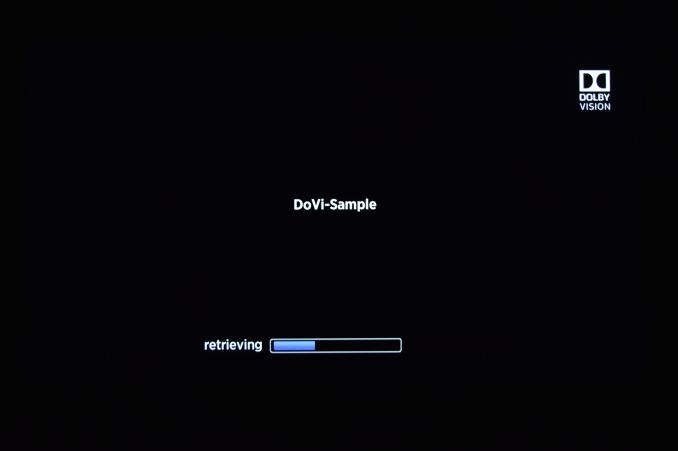

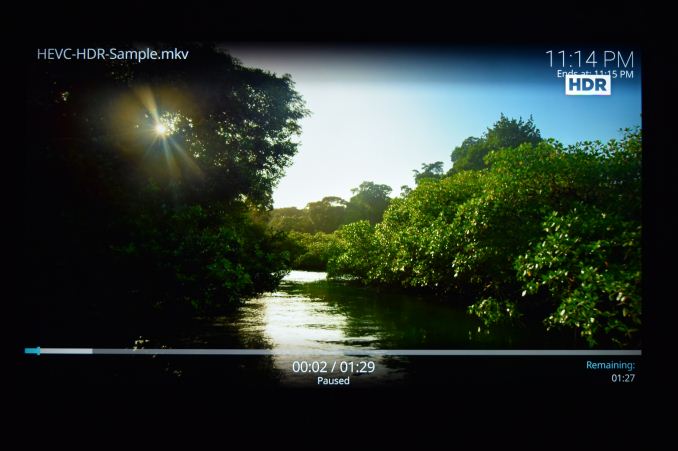
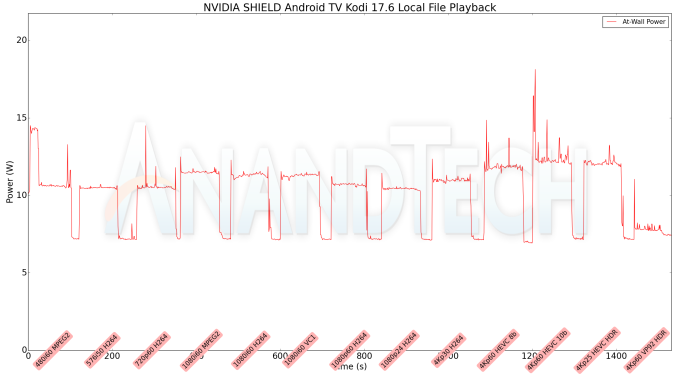
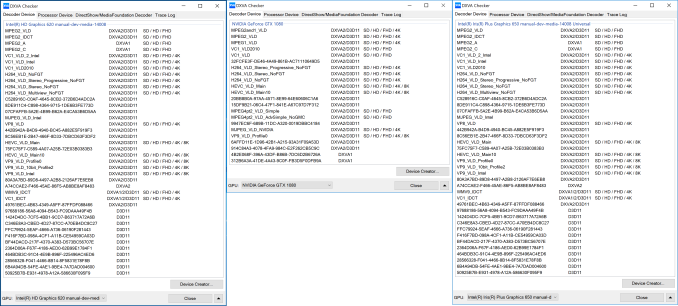
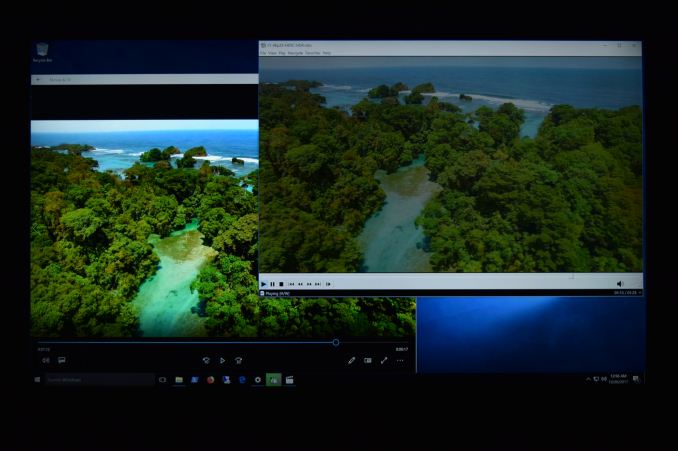
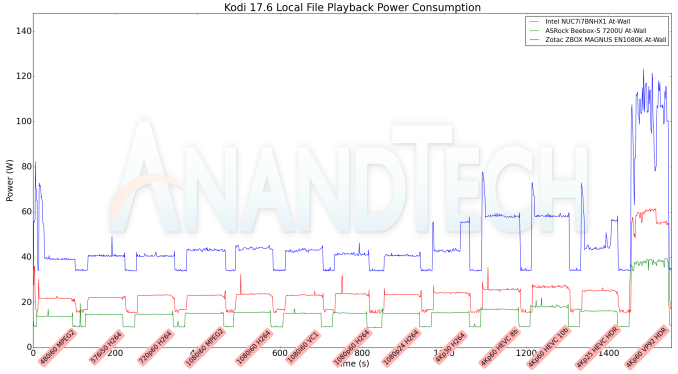










191 Comments
View All Comments
Golgatha777 - Tuesday, December 26, 2017 - link
It doesn't even make financial sense to try and do 4k Blu-ray on PC. The optical drive is $117 and the playback software, PowerDVD 17 is $40 currently. Add to this the requirement for specific motherboards and CPUs for the DRM chain, and you've more than paid for an XBox One S.Not to mention from my anecdotal experiences during the Bluray days, the software will be buggy as hell, the audio will be a pain in the ass to configure correctly, and you'll need to update the software (in this case PowerDVD) to the newest version down the road to keep up with the DRM key refreshes.
I built a HTPC years ago, and it's only still useful because I also use it to game on, and because of software that strips DRM off my discs. Now that commercial playback software must support Cinavia, it's useless to me as well for playing back ripped ISO images and media files; so I turn to open source programs and will keep my old hardware that ignores Cinavia, etc. for playback. For streaming and 4k discs, and XBox One S is much more cost effective, and the playback software will get updated for free going forward (support for new DRM keys, Dolby Vision, Dolby Atmos, etc.).
Golgatha777 - Tuesday, December 26, 2017 - link
Forgot the $26 for a SATA breakout drive enclosure for the 5.25in optical drive.edzieba - Tuesday, December 26, 2017 - link
For regular BD playback, by far the most painless experience is to just use AnyDVDHD and play the movie file directly off of the disc. No mucking about with menus (and waiting for a Java VM to load up just to RUN the menus!), no dealing with the steaming pile of garbage that is PowerDVD, no worrying about having to have an obtuse HDCP compatible chain, etc.Recent developments have shown HDCP 2 is on the way to being broken in a similar way, so soon the only practical requirements may be a BDXL capable drive and a HDR capable monitor/TV.
Fujikoma - Thursday, December 28, 2017 - link
I rip everything to an NAS and strip the Cinavia out of it. It also saves me the hassle of getting off my lazy butt and I can just stream anywhere in my house without a problem. My 4k BD drives cost me less than $70 (LG) and they both work fine for ripping (1950X TR with NVidia 1080). I can use my XBoneS for the odd video files (format, audio and sub options) I have and the Roku (boxes and the t.v. built-ins) work just fine for my h265 MP4s. I think you're right that the XBone platform would be a better option for 4k at this point. I'd use a 4k dedicated player for family, if no one games because it's less complicated. With family, fewer remotes and components has been the way to go. That's why I keep the amps and pre-amp setup in my computer room.The article, itself, doesn't really make any sense because there's too much skimping on the home theatre. Just easier to start with a good t.v. and audio setup with front speakers only, then add in the extra bells and whistles later. The list doesn't even contain a sub... which means a decent sound bar would be viable option to ceiling speakers as the surround setup isn't even in the cost breakdown.
rapster - Sunday, December 31, 2017 - link
How do you strip out Cinavia? Last I heard there still wasn’t a viable solution and would be very glad to hear that the situation has changed.Fujikoma - Sunday, January 7, 2018 - link
I'm not going to list the software, as it already had a run-in with the U.S. govt. and I don't feel like causing myself more hassle again even though I have a legal right to rip my own BD/DVD collection. Considering I (as does everyone in the U.S.) pay a 'fine' to the recording industry every time I purchase recordable/storage media for potential pirating/format change of stuff I own, my attitude towards it is even more jaded. Needless to say, the software was worth the money.Aikouka - Wednesday, December 27, 2017 - link
I wouldn't just flat-out recommend the Xbox One to anyone as a UHD BR player. The Xbox One's biggest problem is that it's far too noisy when playing UHD Blu-rays (disc noise), and it's quite easy to hear during quieter parts of a movie. I went that route to start with, and it only took me one movie to start researching alternatives. Unfortunately, most alternatives have issues too. Sony's player is arguably the one that has the least amount of awkward teething issues, but it'll never support Dolby Vision. (TCL's P605/P607 supports Dolby Vision.) LG was supposed to add it, but they pulled the update. I've also heard complaints of noise from other players. The only player that seems to get decent praise is Oppo's 203, but it's also over twice as expensive as the others (~$500).edlee - Thursday, December 28, 2017 - link
I understand the superiority of Dolby Vision, but the fact that its not widely supported in the tv market, only LG, roku tv, and vizio support the feature. All the support is going to the forthcoming HDR10+, i know its difficult to review right now, but its an open standard and royalty free. You will see support for it from more tv manufacturers as well. It has streaming support from Amazon on over 100 titles, and support is mostly coming from Netflix in the future.Reflex - Thursday, December 28, 2017 - link
And honestly until you get to 80" or higher projector style setups DV is unlikely to make a noticeable difference in image quality. DV is a nice to have, but not at all mandatory for a first class experience, at least not yet.HStewart - Friday, December 29, 2017 - link
I actually have Xbox One S and primary used it for UHD Blu-rays. There is difference in having it on PC then on Xbox - because you can also used it as 4K Monitor which is good fro graphics programs.I would agree for low cost it best to go for Xbox One S ( or X ).
I would think with this Pioneer drive - you should be able to get HULU in 4k on PC - but even with the Xbox you will need 13 megabit Internet connection to run 4k HULU.